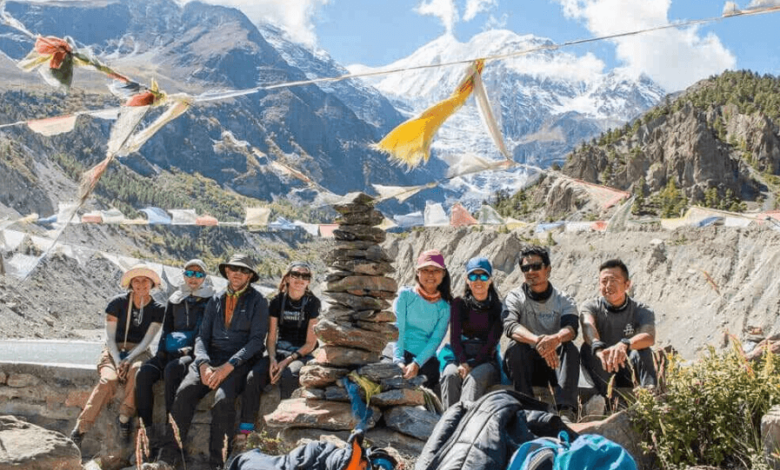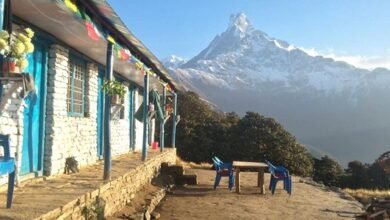Samdo Village: The Hidden Gem on the Manaslu Circuit Trek

Situated in the shadows of the mighty Himalayas in the Manaslu region, just a few kilometres away from the Tibetan border, lies Samdo Village. It’s a serene Himalayan village where nature, culture, and solitude exist in a perfect triad.
At an altitude of 3875 meters (12,712 ft), this remote hamlet isn’t just a resting point on the Manaslu Tsum Valley Trek; it’s a cultural encounter, a gateway to ancient trade routes, and a testament to life in the high Himalayas.
For trekkers seeking an authentic Himalayan experience away from the crowds of Annapurna and Everest, Samdo delivers something truly rare: untouched beauty and genuine connection.
A Village Built on Resilience and Tradition
Samdo was established by Tibetan refugees, many of whom fled to Nepal decades ago. Today, the village remains almost purely Tibetan in heritage. There lives a total population of around 200 people, maintaining deep spiritual and cultural ties to Tibet.
As you wander through the narrow alleys and pass by stone-built homes adorned with prayer flags, you’ll witness a lifestyle preserved across generations.
It’s not just the architecture or the language that speaks of Tibet—it’s the very essence of life here. The villagers still rely heavily on yak herding, cultivation, and seasonal trade.
Some families continue the long-standing tradition of bartering across the border. Though today, it’s more symbolic than commercial.
See also: Top 3 Fantastic Travel Attractions in Rome
A Crucial Stop on the Manaslu Circuit
The Manaslu Circuit Trek has gained popularity in recent years, but it remains far less explored than its more famous neighbors. Samdo was strategically located two days before the Larkya La Pass (5160 m/16,752 ft), the trek’s highest point. Samdo is a critical acclimatization stop on the route. But it’s much more than a place to catch your breath.
Trekkers who arrive in Samdo after days of ascending through lush forests, steep ridges, and glacial rivers are often taken aback by the village’s stark beauty.
Surrounded by windswept cliffs and towering peaks, Samdo offers a 360-degree view of the snow-capped giants, including Manaslu, Pang Phuchi, and Samdo Peak. It whispers the tales of the trans-Himalayan routes once used by salt traders and pilgrims.
What Makes Samdo Unique?
Himalayan Silence, Undisturbed
Unlike Namche Bazaar or Ghorepani, Samdo is a relatively remote and beautiful destination. No honking jeeps, no bustling markets. Just the wind, the bells on yaks, and the murmurs of prayer.
Acclimatization Hike to Samdo Ri
A short yet steep climb behind the village leads to Samdo Ri (5177 m/16,985 ft), a popular acclimatization hike that offers jaw-dropping views of Manaslu, the Tibet border, and the glacier-carved valleys below. It’s one of those rare hikes where the journey and destination are equally rewarding.
Proximity to the Tibet Border
From Samdo, the border lies just 4 km away. While crossing is restricted, the proximity gives trekkers a rare sense of standing at a cultural crossroads between Nepal and Tibet. Some guided treks even take you to viewpoints overlooking the ancient trade routes that snake into the misty lands beyond.
People and Their Stories
Because the village sees fewer visitors than most trekking hotspots, locals are still curious and warm. If you’re lucky, you might get invited into a traditional stone house for salted butter tea or Tsampa (roasted barley flour) and hear tales of snowy winters, border crossings, or life under the mountains.
Staying in Samdo: The Essentials
While Samdo is remote, the teahouses here are welcoming and warm. Don’t expect luxury—wooden beds, wool blankets, and a central fire stove are the norms—but the comfort lies in the smiles and the simplicity.
Meals are hearty, with Dal Bhat, Mo: Mo and potato stew being the most common options here. Most trekkers take an extra acclimatization day here before heading to Dharmashala and then over the Larkya La Pass.
Electricity is scarce and solar-powered, so charging devices may cost extra. There is no mobile signal, although some lodges offer satellite Wi-Fi for a fee. Still, most choose to unplug and soak in the peaceful rhythm of mountain life.
When to Visit Samdo
The best time to trek through Samdo is, no doubt, during the spring (March to May) and autumn (September to November) seasons. These seasons offer the clearest skies, comfortable temperatures, and the safest conditions for crossing the Larkya La Pass.
In winter, Samdo transforms into a snow-covered village, often inaccessible due to heavy snowfall.
Final Thoughts: More Than Just a Stopover
To call Samdo just an acclimatization village in the Manaslu Circuit Trek route would be an understatement. It’s more than that. It’s about the stories sung by each stone, heart-warming sunrise and sunset views, culture, and lifestyle.
Trekkers who venture here often say that Samdo changed their perspective on what trekking in the Himalayas truly means.
It’s not just about walking on high-altitude terrains or rushing to the next viewpoint. It’s about making time, self-realization, fresh mountain air, and so many other things. The scent of juniper smoke and walking in the footprints of those who’ve journeyed across these hills for centuries.


